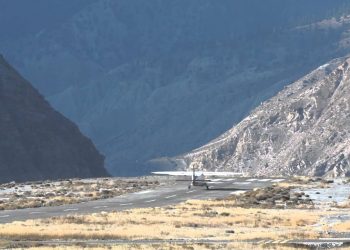Nepal, which earlier hesitated to completely pivot towards China because of several economic and geopolitical factors, seems to have tilted heavily towards its big northern neighbor, giving it an opportunity to further increase its footprint in the Himalayan country’s political, economic, and social space.
Yet what concerns Nepal watchers the most is the Himalayan nation’s move to give China a much-needed break to enter an area which was so far virgin—oil and gas exploration.
In 1985, Nepal had invited foreign companies to look for oil and gas.
Shell and Triton Energy had conducted a seismic survey and drilled a 3,520-meter well to test the possibility of oil, but that yielded no results.
Even as China continues to stir discontent among Nepalese people over the Belt and Road Initiative. In May 2017, Nepal-headed by Prachanda and China had signed a Memorandum of Understanding on BRI.
Both foreign companies withdrew from oil and gas exploration bids in Nepal in 1990.
However, in the early weeks of May 2024, a team of about 20 Chinese engineers along with 45 Nepali technicians began drilling for oil in Dailekh, which lies more than 644 km away from Kathmandu, said The Rising Nepal.
The Nepalese government-backed English-language newspaper said tools and equipment for the exploration of petroleum products arrived in the Himalayan country from China in trucks in April this year.
Another Nepali newspaper, Kantipur, said Chinese and Nepali technicians conducted four surveys: seismic survey, geological survey, magnetotelluric survey, and geochemical sampling survey.
They also carried out a feasibility study before going for exploration through oil drill machines in the second phase, Kantipur said.
For exploration, as per The Rising Nepal, an agreement was signed between the Nepal government’s Department of Mines and Geology and the Chinese government’s Geological Survey Company in 2019 for the financial and technical support for the exploration and extraction of petroleum products.
It will be the first oil and gas exploration in Nepal since 1985 when a similar attempt to explore oil in the Himalayan country yielded no results.
Observers see the latest project as an attempt by China to further enhance its influence in Nepal, a small Himalayan nation which is currently run by Pushpa Kamal Dahal ‘Prachanda,’ whose inclination towards China is well known.
In March this year, he ditched the Nepali Congress, a liberal democratic party for staunch China ally K P Sharma Oli, chief of the Communist Party of Nepal (United Marxist-Leninist) to run his government.
China was quick to congratulate the alliance government of Prachanda-led Communist Party of Nepal (Maoist Centre) and K P Sharma Oli-led Communist Party of Nepal (United Marxist-Leninist).
It signified the Communist alliance’s resurgence which was first formed in Nepal with assistance from then Chinese Ambassador to Kathmandu, Yu Hong in 2017. China had then denied its interference in the political affairs of Nepal.
A similar approach was taken by it when media claimed that it played a behind-the-scenes role in the formation of the Prachanda-led new coalition government in Nepal in March 2024.
As per a survey document released by Nepal’s Ministry of Agriculture in November 2022, China has encroached on 36 hectares of the Himalayan nation’s land at 10 places on the northern border by China.
Because, soon after the formation of the government, a Chinese military delegation visited Nepal and later pledged to “beef up” defense cooperation, Nikkie Asia said.
While it indicated clearly about Beijing’s attempt to consolidate its hold on Nepal, it also hinted about the East Asian country’s bid to influence every aspect of life in the Himalayan nation.
Even as China continues to stir discontent among Nepalese people over the Belt and Road Initiative. In May 2017, Nepal-headed by Prachanda and China had signed a Memorandum of Understanding on BRI.
The framework agreement was hailed by the Himalayan nation as a watershed moment in Nepal-China relations as it hoped that it would attract Chinese investment to the country.
However, seven years have passed since the BRI agreement was signed, not a single project, out of the total nine different projects which included the trans-Himalayan railway connecting from China’s Jilong/Keyrung to Kathmandu, an extension of a 400 KV electricity transmission line, setting up a technical university and the construction of tunnels, roads, and hydroelectricity dams—has been implemented.
The reason behind non-implementation of BRI projects in Nepal is China’s insistence that it will not fund them under grant assistance programs.
The East Asian country does not want to treat BRI projects in Nepal differently from similar kinds of projects implemented by it in other parts of the world.
It wants to fund projects in Nepal under commercial loans—a major source of worries for people in the Himalayan nation given such loans’ potential to create an economic crisis like the one in Sri Lanka, Zambia, and other parts of the world.
Already, Nepal is struggling with China-funded Pokhara International Airport; mired in corruption, the $305 million airport has become a white elephant like China-constructed Matale airport and Hambantota port in Sri Lanka.
Built by the China CAMC Engineering Co Ltd, Beijing has unilaterally declared Pokhara International Airport as a part of its BRI program.
It has failed to attract any regular international flights since its inauguration on January 1, 2023, by Prime Minister Prachanda.
But the East Asian country has not rectified the error so far. Ironically, when such developments demand a rational approach, Nepal continues to throw the red carpet welcome to China and treat its leaders with warm hugs.
However, since Nepal is saddled with a government that is thoroughly pro-China, Kathmandu is not able to exert pressure on Beijing despite its unhealthy economic practices and expansionist approach.
As per a survey document released by Nepal’s Ministry of Agriculture in November 2022, China has encroached on 36 hectares of the Himalayan nation’s land at 10 places on the northern border by China.
In prominent Nepal districts like Gorkha and Humla, China’s alleged encroachment has become a matter of huge concern among people.
Both the countries share nearly 1,400 km of border along the Himalayan mountains.
And, they have also signed a series of treaties to maintain the status quo on the border in the early 1960s.
Despite this, China bats no eyelid in executing its salami-slice strategy against Nepal.
Last year, Beijing issued a new standard map which failed to recognize Nepal’s new map.
Instead, the new standard map recognizes Nepalese territories as those belonging to the Himalayan nation’s neighbor.
This created a furore in Nepal’s civic and political circles, and Prime Minister Prachanda raised it during his visit to China in September last year.
But the East Asian country has not rectified the error so far. Ironically, when such developments demand a rational approach, Nepal continues to throw the red carpet welcome to China and treat its leaders with warm hugs.









Comment